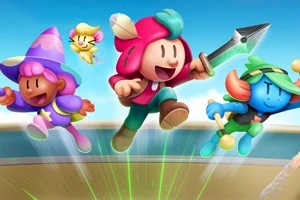Feature: The End Of Split-Screen?

Posted 16 Mar 2006 at 20:35 by guest

| "And of course there are the costs involved... all for the privilege of hearing juvenile insults in a by-the-numbers FPS. Are we having fun yet?" |
Through the last two generations of Nintendo home consoles, from the N64 to the GameCube, there is one feature that has brought people together in front of television screens to shout and laugh and throw controllers in fits of frustration: split-screen multiplayer. As online gaming comes of age, now is a good time to consider Nintendo's multiplayer legacy.
Blue Shell of Death
Four controllers. The idea is so simple, but this ability to plug in four joypads and play split-screen with friends was crucial to the popularity of many N64 games. The multiplayer favourites of the N64 have given gamers some of their fondest memories. Mario Kart 64 was a revelation, delivering multiplayer carnage in battle mode and racing perfection in versus mode. That is all abstract though. Each gamer has their own recollections, whether it is the desperate, panicked effort to outrun a red shell (or the crushing, inevitable defeat inflicted by a blue one); perhaps it was the attempt to beat the train (or brake in enough time) in Kalimari Desert; or the adrenaline rush at racing through a power-up block, triggering Z to use an item before an opponent launched a shell. It may simply be the desperate last seconds of a race, literally neck-and-neck as the players hurtle towards the finishing line, and the humiliation of finishing fourth. Mario Kart 64 is probably not the most accomplished game in the series, but in terms of multiplayer laughs cannot be faulted.
GoldenEye was the defining multiplayer title of that generation. Gamers bought the N64 for GoldenEye; even if they did not part with their cash, they made sure they fell in with friends who did. Split-screen, 007 characters, real weapons, tight levels and a range of options. Each multiplayer game of GoldenEye was unique to its players, and their experiences are unique. Everybody has their own set-up: whether it was remote mines in the facility, rocket launchers in the temple, capture the flag or team-based matches; or Licence to Kill, with auto-aim disabled, armed with pistols in the basement (one for the strong of nerve this). GoldenEye was about visceral, nervous action � playing the game with friends led to shouts of joy as long-range grenades hit home, or as remote mines were detonated at the right time. GoldenEye was about the panic of hearing the high-pitched drone and seeing the smoke trail of rockets being launched, and the evolving strategies as gamers kept an eye on their opponents' and allies' actions. This is another split-screen plus: since there is no refuge from enemy eyes, strategies must be refined and reworked constantly. Apart from anything else, split-screen is the great equaliser. Expert players cannot conceal their movements, cannot camp out on ammo pickups and get away with it. Nobody can rely on the element of surprise: pure skill is all that counts.
Honourable mention must be made of Perfect Dark (particularly its range of options, challenges and weapons, including the Laptop Gun, which doubled as a remote gun turret, and the Slayer, which allowed missiles to be guided to their targets), the original Super Smash Bros. , the inspired Mario Tennis, and third-party favourites including countless wrestling games, Konami's International Superstar Soccer series, F-Zero X and Micro Machines 64 (eight player chaos there). Everybody's multiplayer memories will be different yet will also be the same. We all made (and sometimes lost!) friends over N64 games and grew up with them.
Oh! Mayhem
Four-player multiplayer found its way into 2002 with the release of GameCube, in spite of the rise of online gaming and Nintendo's rivals committing themselves to the broadband era. Mario Kart: Double Dash!! divided the fans, but still offered an enjoyable multiplayer mode (and a welcome "tightening" of Mario Kart 64's overlong tracks). Super Smash Bros. Melee became the firm four-player favourite of this generation, and lived up to its subtitle: this one was pure mayhem.
In terms of multiplayer genius, it is Sega and Amusement Vision who must take the crown this time around. Super Monkey Ball is a pitch-perfect party game. The range of mini-games � the strategy and skill of Monkey Target, the hectic battles of Monkey Fight, and the addictive Monkey Bowling � has provided some of this generation's greatest multiplayer gameplay. Nintendo did not disappoint either, and Camelot's Mario Power Tennis is as near a flawless multiplayer experience as you could hope for. A game of doubles involves feverish rallies and intense struggles for a game point, while team players encourage (or berate) their partner's performances. Both these games are simple to control and immediately accessible (to non-gamers as well as hardcore gamers) but with much tactical depth.
"Mutant monster"
The last few years have witnessed the rise of broadband and online gaming, apparently signalling the end of split-screen, four-player multiplayer. Microsoft has pushed Xbox Live! and Sony has made inroads with the PS2. Yet for all plugging there has been precious little impact on the vast majority of gamers (90% of Xbox owners do not play online). Those approaching online for the first time were not welcomed by what Reggie once described as an "overly macho" culture; abusive language and rampant immaturity seems to be par for the Internet gaming course. And of course there are the costs involved, for the consoles, the games, your Internet, and the subscription fee � all for the privilege of hearing juvenile insults in a by-the-numbers FPS. Are we having fun yet?
To compound it all there are the online hype merchants. Raph Koster, the Chief Creative Officer at Sony Online Entertainment � and the man behind the calamitous Star Wars Galaxies � recently claimed: "The entire video game industry's history thus far has been an aberration. It has been a mutant monster only made possible by unconnected computers. " This may come as news to the gaming community who have enjoyed this "aberration" for the last 20 years. Not only is this lamentable rhetoric, it is inept business sense: unless industry types believe that berating the history of gaming is a sure-fire way to win support to their cause (hint: it's not). Just as gamers such as myself � somewhat uncertain about signing up for the online future � were gradually warming to the idea of Internet play, along comes some vapid, off-putting remarks about how my love of games is actually an "aberration".
Koster continued: "People always play games together. All of you learned to play games with each other. When you were kids, you played tag, tea parties, cops and robbers, what have you. The single-player game is a strange mutant monster which has only existed for 21 years and is about to go away because it is unnatural and abnormal. "
Aside from the fact that most gamers probably did not grow up playing at tea parties, and that single player is not "about to go away" (an especially weak judgment, given the majority of gamers not playing online), Mr. Koster makes a solid observation: that people do indeed play games together. In order to further his point about online as the way of the future however, Mr. Koster has to omit split-screen multiplayer entirely.
Fourgone conclusion
And so it is oft repeated, but it is worth saying again: a television, an N64, four pads, a group of friends, and Mario Kart. The experience of winning and losing in company is unsurpassed. As a good friend of mine emailed me recently, "4-player is all about getting in some beers and crisps and getting in each other's face. It's a social event. You can't do any of that online." Gamers have bonded over their experiences of school, in sports, in university and beyond, and through it all has been those four pads and a group of friends.
This last generation has witnessed an admittedly short-lived attempt to push online as "social gaming", which is nonsensical. It is absurd to describe online gaming as "social" when compared to a four-player mode. Playing games over the Internet, connected by miles of cable and a headset, is not social: it is still an individual experience. Only split-screen has that immediacy and the sheer adrenaline factor.
Yet all is not gloomy for hardened online cynics. It is hard to dislike Nintendo's Wi-Fi Connection plans, particularly its lack of subscription fees and promise of proven multiplayer hits. The DS has been a huge success and the take-up rate for online games has been sizeable. But to Nintendo and other developers out there: do not abandon four-player. There is nothing quite like it.
Nick Bennett
[email protected]






















